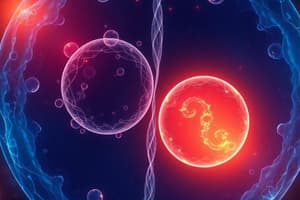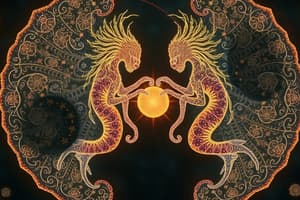Podcast
Questions and Answers
What are the functions of mitotic cell division?
What are the functions of mitotic cell division?
Replacement of cells, growth of multicellular organisms, and asexual reproduction.
Which of the following are products of cell division by mitosis?
Which of the following are products of cell division by mitosis?
- Four cells genetically identical to the original cell
- Two cells genetically identical to the original cell (correct)
- One cell genetically identical to the original cell
- Three cells genetically identical to the original cell
Select the reasons why meiosis typically produces genetic variation, whereas mitosis does not.
Select the reasons why meiosis typically produces genetic variation, whereas mitosis does not.
- Sister chromatids are genetically identical
- Crossing over occurs during meiosis (correct)
- Independent assortment of chromosomes (correct)
- Mitosis produces identical daughter cells (correct)
What is a telocentric chromosome?
What is a telocentric chromosome?
What is a submetacentric chromosome?
What is a submetacentric chromosome?
What is a metacentric chromosome?
What is a metacentric chromosome?
What is an acrocentric chromosome?
What is an acrocentric chromosome?
What difference is observed during prophase of mitosis between haploid and diploid cells?
What difference is observed during prophase of mitosis between haploid and diploid cells?
What happens during anaphase I of meiosis?
What happens during anaphase I of meiosis?
What happens during prophase I of meiosis?
What happens during prophase I of meiosis?
What happens during telophase II of meiosis?
What happens during telophase II of meiosis?
How many chromosomes and DNA molecules does the primary spermatocyte of a rat have if its somatic cell contains 42 chromosomes?
How many chromosomes and DNA molecules does the primary spermatocyte of a rat have if its somatic cell contains 42 chromosomes?
A male giant panda has 42 chromosomes in its skin cells. This represents the __________ chromosome number.
A male giant panda has 42 chromosomes in its skin cells. This represents the __________ chromosome number.
As the animal's old skin cells die and slough off, cells nearby divide through _____________ to produce more skin cells.
As the animal's old skin cells die and slough off, cells nearby divide through _____________ to produce more skin cells.
Germ cells within the animal's testicles undergo ______________ to replicate themselves and _______________ to produce sperm.
Germ cells within the animal's testicles undergo ______________ to replicate themselves and _______________ to produce sperm.
The cells produced by mitosis in this panda have a __________ chromosome number and are produced after ___________ are pulled apart into separate daughter cells.
The cells produced by mitosis in this panda have a __________ chromosome number and are produced after ___________ are pulled apart into separate daughter cells.
The cells produced by meiosis I in this panda have a _____________ chromosome number and are produced after _________________ have been pulled apart into separate daughter cells.
The cells produced by meiosis I in this panda have a _____________ chromosome number and are produced after _________________ have been pulled apart into separate daughter cells.
The cells produced by meiosis II in this animal have a ____________________ chromosome number and are produced after ______________ have been pulled apart into separate daughter cells.
The cells produced by meiosis II in this animal have a ____________________ chromosome number and are produced after ______________ have been pulled apart into separate daughter cells.
Order the events of meiotic crossover from the start of prophase I to the start of metaphase I.
Order the events of meiotic crossover from the start of prophase I to the start of metaphase I.
Flashcards
Mitosis function
Mitosis function
Cell division for growth, repair, and asexual reproduction in single-celled organisms.
Mitosis products
Mitosis products
Two identical diploid daughter cells.
Meiosis variation
Meiosis variation
Crossing over and independent assortment create genetic diversity.
Telocentric chromosome
Telocentric chromosome
Signup and view all the flashcards
Submetacentric chromosome
Submetacentric chromosome
Signup and view all the flashcards
Metacentric chromosome
Metacentric chromosome
Signup and view all the flashcards
Acrocentric chromosome
Acrocentric chromosome
Signup and view all the flashcards
Meiosis I outcome
Meiosis I outcome
Signup and view all the flashcards
Meiosis II outcome
Meiosis II outcome
Signup and view all the flashcards
Meiotic crossover
Meiotic crossover
Signup and view all the flashcards
Prophase I (Meiosis)
Prophase I (Meiosis)
Signup and view all the flashcards
Anaphase I (Meiosis)
Anaphase I (Meiosis)
Signup and view all the flashcards
Telophase II (Meiosis)
Telophase II (Meiosis)
Signup and view all the flashcards
Mitosis vs. Meiosis
Mitosis vs. Meiosis
Signup and view all the flashcards
Diploid chromosome number
Diploid chromosome number
Signup and view all the flashcards
Interphase (Meiosis)
Interphase (Meiosis)
Signup and view all the flashcards
Skin cell division
Skin cell division
Signup and view all the flashcards
Germ cell division
Germ cell division
Signup and view all the flashcards
Study Notes
Functions of Mitotic Cell Division
- Cell division serves to replace damaged or dead cells, ensuring the longevity of multicellular organisms.
- Mitosis facilitates growth in multicellular organisms, producing new cells for tissue expansion.
- Asexual reproduction is achieved through mitotic division in some single-celled organisms.
Products of Mitosis
- Mitosis results in two daughter cells that are genetically identical to the original parent cell.
Mitosis vs. Meiosis
- Mitosis produces two identical diploid daughter cells, maintaining genetic consistency.
- Meiosis introduces genetic variation due to:
- Crossing over that occurs between homologous chromosomes.
- Independent assortment, which enables different combinations of alleles to be passed to gametes.
Chromosome Types
- Telocentric chromosomes have their centromere located at one end.
- Submetacentric chromosomes have their centromere slightly off-center, resulting in one arm being longer than the other.
- Metacentric chromosomes have a centrally located centromere, leading to two arms of equal length.
- Acrocentric chromosomes have a centromere located close to one end, causing one arm to be significantly shorter.
Differences in Cell Composition During Mitosis
- During prophase of mitosis, the haploid cell contains one pair of DNA molecules, while the diploid cell has two pairs.
Stages of Meiosis
- Interphase allows for chromosome replication before meiosis begins.
- Prophase I involves homologous chromosomes pairing and crossing over.
- Metaphase I has homologous pairs aligning in the center of the cell.
- Anaphase I separates homologous chromosomes, unlike in mitosis where sister chromatids separate.
- Telophase I and cytokinesis produce two haploid daughter cells.
- Prophase II sees the reforming of spindle fibers.
- In Metaphase II, sister chromatids align at the cell's center.
- Anaphase II results in the separation of sister chromatids.
- Telophase II and cytokinesis yield four haploid cells.
Chromosomal Behavior in Meiosis
- Anaphase I: Homologous chromosomes separate, while sister chromatids remain attached.
- Prophase I: Formation of homologous chromosome pairs and crossing over occurs.
- Telophase II: Nuclear membrane forms around haploid chromosome sets.
Chromosome Numbers in Animals
- In rats, the primary spermatocyte (2n = 42) contains 42 chromosomes and 84 DNA molecules due to replication.
- Diploid chromosome number is indicated by the total count in somatic cells, such as that in giant pandas (42 chromosomes).
Cell Division Processes in Animals
- Skin cells divide through mitosis to replace old or damaged cells.
- Germ cells undergo mitosis to replicate, followed by meiosis to produce sperm.
Chromosome Number in Meiosis
- Mitosis results in diploid cells post-separation of sister chromatids.
- Meiosis I results in haploid cells following the separation of homologous chromosomes.
- Meiosis II results in haploid cells after the separation of sister chromatids.
Meiotic Crossover Events
- Events of meiotic crossover include chromosome condensation, homolog alignment, crossing over, chiasmata formation, and further condensation as chiasmata become visible.
Studying That Suits You
Use AI to generate personalized quizzes and flashcards to suit your learning preferences.




